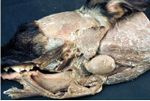Difference between revisions of "Mandibular Gland - Anatomy & Physiology"
Jump to navigation
Jump to search
Fiorecastro (talk | contribs) |
m (Text replace - '|maplink = Alimentary (Concept Map)- Anatomy & Physiology' to '|maplink = ') |
||
| (27 intermediate revisions by 6 users not shown) | |||
| Line 1: | Line 1: | ||
| + | {{toplink | ||
| + | |backcolour =BCED91 | ||
| + | |linkpage =Alimentary - Anatomy & Physiology | ||
| + | |linktext =Alimentary System | ||
| + | |maplink = | ||
| + | |pagetype =Anatomy | ||
| + | |sublink1=Oral Cavity - Salivary Glands - Anatomy & Physiology#Major Salivary Glands | ||
| + | |subtext1=MAJOR SALIVARY GLANDS | ||
| + | }} | ||
| + | <br> | ||
| + | ==Mandibular Salivary Gland== | ||
| + | [[Image:Parotid & Mandibular Salivary Gland.jpg|thumb|right|150px|Mandibular Salivary Gland - Copyright Nottingham 2008]] | ||
| + | *Mixed gland - [[Serous Salivary Gland - Anatomy and Physiology|serous]] and [[Mucous Salivary Gland - Anatomy & Physiology|mucous]] secretion | ||
| + | |||
| + | *Merocrine secretion | ||
| + | |||
| + | *Generally smaller than the [[Parotid Gland - Anatomy & Physiology|parotid]] gland | ||
| + | |||
| + | *It is a moderately large gland in carnivores | ||
| + | |||
| + | *It is a large gland in herbivores | ||
| + | |||
| + | *Compact | ||
| + | |||
| + | *Located around angle of jaw | ||
| − | + | *Mandibular duct runs ventral to mucous membrane of floor of [[Oral Cavity Overview - Anatomy & Physiology|oral cavity]], close to frenulum of [[Oral Cavity - Tongue - Anatomy & Physiology|tongue]] | |
| − | [[ | ||
| − | |||
| − | |||
| − | + | *Duct opens at sublingual caruncle | |
| + | |||
| + | *Innervated by facial nerve ([[Cranial Nerves - Anatomy & Physiology|CN VII]]) via chordi tympanii of trigeminal ([[Cranial Nerves - Anatomy & Physiology|CN V]]) | ||
==Histology== | ==Histology== | ||
| − | + | *Tubulo-acinar gland | |
| + | |||
| + | *[[Mucous Salivary Gland - Anatomy & Physiology|Mucous]] cells (stain lighter) | ||
| + | |||
| + | *[[Serous Salivary Gland - Anatomy and Physiology|Serous]] demilunes (stain darker) | ||
| − | + | *Demilunes secrete into lumen by canaliculi between mucous cells | |
| − | |||
==Species Differences== | ==Species Differences== | ||
| − | + | '''Carnivores''' | |
| − | + | *Mainly [[Mucous Salivary Gland - Anatomy & Physiology|mucous]] secretion in dog and cat | |
| − | + | *Oval shape in canid | |
| − | |||
| − | |||
| − | |||
| − | |||
| − | |||
| − | |||
| − | |||
| − | + | '''Herbivores''' | |
| − | + | *Larger and deeper | |
| − | |||
| − | |||
| − | |||
Revision as of 00:01, 3 July 2010
|
|
Mandibular Salivary Gland
- Merocrine secretion
- Generally smaller than the parotid gland
- It is a moderately large gland in carnivores
- It is a large gland in herbivores
- Compact
- Located around angle of jaw
- Mandibular duct runs ventral to mucous membrane of floor of oral cavity, close to frenulum of tongue
- Duct opens at sublingual caruncle
Histology
- Tubulo-acinar gland
- Mucous cells (stain lighter)
- Serous demilunes (stain darker)
- Demilunes secrete into lumen by canaliculi between mucous cells
Species Differences
Carnivores
- Mainly mucous secretion in dog and cat
- Oval shape in canid
Herbivores
- Larger and deeper
